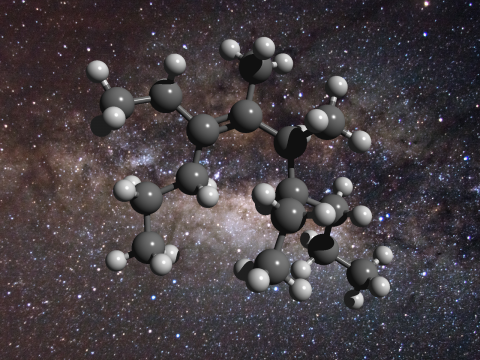The galaxy is rich in grease-like molecules, according to an Australian-Turkish team. Astronomers at the University of New South Wales in Sydney (UNSW), and Ege University in Turkey used a laboratory to manufacture material with the same properties as interstellar dust and used their results to estimate the amount of ‘space grease’ found in the Milky Way. Their results appear in a paper in Monthly Notices of the Royal Astronomical Society.

Organic matter of different kinds contains carbon, an element considered essential for life. There is though real uncertainty over its abundance, and only half the carbon expected is found between the stars in its pure form. The rest is chemically bound in two main forms, grease-like (aliphatic) and mothball-like (aromatic).
The UNSW / Ege team used a laboratory to create material with the same properties as interstellar dust. They mimicked the process by which organic molecules are synthesised in the outflows of carbon stars, by expanding a carbon-containing plasma into a vacuum at low temperature. The material was collected and then analysed by a combination of techniques. Using magnetic resonance and spectroscopy (splitting light into its constituent wavelengths) they were able to determine how strongly the material absorbed light with a certain infrared wavelength, a marker for aliphatic carbon.
“Combining our lab results with observations from astronomical observatories allows us to measure the amount of aliphatic carbon between us and the stars”, explained Professor Tim Schmidt, from the Australian Research Council Centre of Excellence in Exciton Science in the School of Chemistry at UNSW Sydney.
The researchers found that there are about 100 greasy carbon atoms for every million hydrogen atoms, accounting for between a quarter and a half of the available carbon. In the Milky Way Galaxy, this amounts to about 10 billion trillion trillion tonnes of greasy matter, or enough for 40 trillion trillion trillion packs of butter.
Schmidt is quick to dispel the comparison with anything edible: “This space grease is not the kind of thing you’d want to spread on a slice of toast! It’s dirty, likely toxic and only forms in the environment of interstellar space (and our laboratory). It’s also intriguing that organic material of this kind – material that gets incorporated into planetary systems – is so abundant.”
The team now wants to determine the abundance of the mothball-like carbon, which will involve yet more challenging work in the laboratory. By firmly establishing the amount of each type of carbon in the dust, they will know precisely how much of this element is available to create life.
Media contacts
Dr Robert Massey
Royal Astronomical Society
Tel: +44 (0)20 7292 3979
Mob: +44 (0)7802 877 699
rmassey@ras.ac.uk
Dr Helen Klus
Royal Astronomical Society
Tel: +44 (0)20 7734 3307 x 115
hklus@ras.ac.uk
Science contact
Prof Tim Schmidt
University of New South Wales, Sydney
Australia
Mob: +61 439 386 109
timothy.schmidt@unsw.edu.au
Further information
The new work appears in “Aliphatic Hydrocarbon Content of Interstellar Dust”, B. Günay, T. W. Schmidt, M. G. Burton, M. Afşar, O. Krechkivska, K. Nauta, S. H. Kable and A. Rawal, Monthly Notices of the Royal Astronomical Society, Oxford University Press, in press.
Notes for editors
The Royal Astronomical Society (RAS), founded in 1820, encourages and promotes the study of astronomy, solar-system science, geophysics and closely related branches of science. The RAS organizes scientific meetings, publishes international research and review journals, recognizes outstanding achievements by the award of medals and prizes, maintains an extensive library, supports education through grants and outreach activities and represents UK astronomy nationally and internationally. Its more than 4,000 members (Fellows), a third based overseas, include scientific researchers in universities, observatories and laboratories as well as historians of astronomy and others.
The RAS accepts papers for its journals based on the principle of peer review, in which fellow experts on the editorial boards accept the paper as worth considering. The Society issues press releases based on a similar principle, but the organisations and scientists concerned have overall responsibility for their content.

